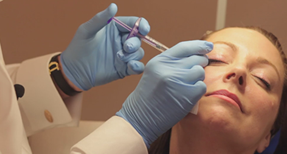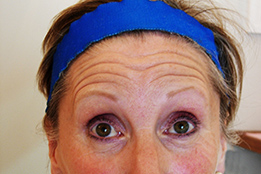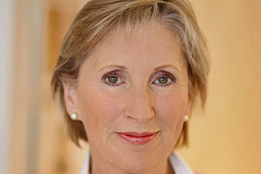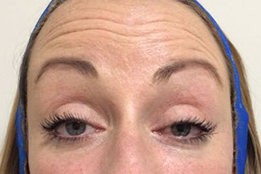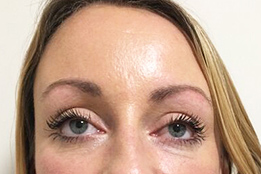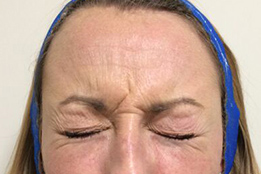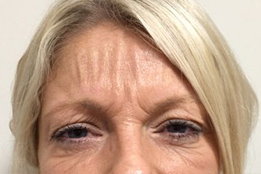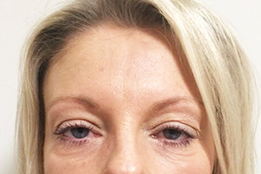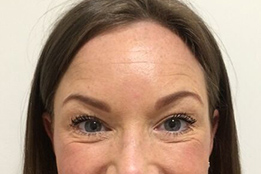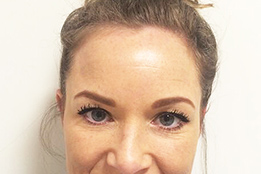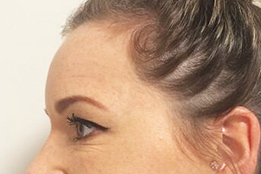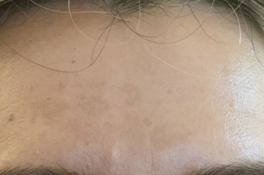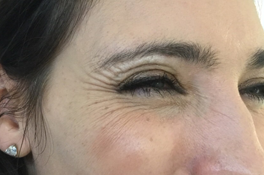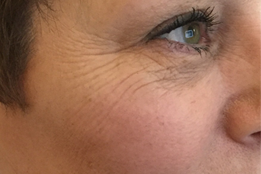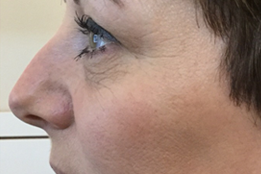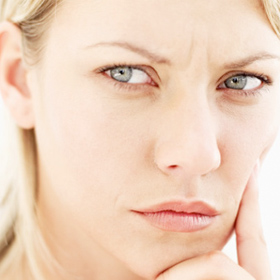
Frown Lines & Deep Frown Lines
Above the bridge of the nose
Frown lines are the small vertical lines that appear between the eyebrows. They are caused by the Corrugator muscles pulling the brow down and inwards. They may appear if you’re someone who frowns a lot or if you spend a lot of time in the sun; they can also appear as a result of ageing.
By injecting Botox into this area, we can smooth away your frown lines, giving your face a more relaxed, less stressed and smoother look. If the frown lines are deep or obvious at rest, superficial use of a fine Dermal Filler is helpful in addition to Botox.
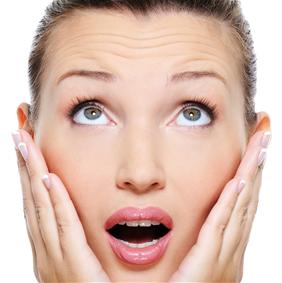
Forehead Lines
Horizontal lines between the hairline and eyebrows
Forehead wrinkles are the long horizontal lines that appear across your forehead. They will probably be more prominent when you raise your eyebrows. These lines can give you a cross appearance and give away your age. Once again, by injecting Botox into the muscles that cause forehead wrinkles, we can smooth away these lines.
As we still want your face to look natural and take a ‘less is more’ approach to Botox treatments, your face will still be expressive. Sometimes we also can treat a deeper frown line with dermal fillers.
Crow’s Feet
Lines radiating outwards from the corners of the eyes
Crow’s feet are the lines that extend from the outer corner of your eyes and are often called ‘laughter’ or ‘smile’ lines because they tend to be more prominent when you laugh or smile. Most of us get crow’s feet as we grow older, simply because the skin loses elasticity and this is an area of the face that does a lot of moving. If you spend a lot of time in the sun, this can make your crow’s feet more prominent.
Bunny Lines
Those small lines that appear along the side of the nose
Not everyone gets bunny lines but they’re the small wrinkles that appear at the top of your nose when you wrinkle your nose, squint or frown. While the name might be cute, many people feel that bunny lines age their face. We can improve or even entirely smooth away their appearance using Botox injections.
Lower Jaw Definition
We can reducing the jowl look under the lower jaw and enhancing the contouring of the jaw line. As your skin loses some of its elasticity over time, you may notice that you’re losing definition around your lower jaw. This can give your face an older, more ‘jowly’ appearance. At Maison Aesthetique, we are skilled at using Botox to reduce the jowl look under the lower jaw.
Smokers’ Lines
The small vertical lines that appear above your top lip
With the passage of time we develop vertical lines along the top lip and less so around the lower lip. Although non-smokers often get these lines as they grow older, they tend to be more prominent in smokers, which is why the lines have been given this name. If you wear lipstick, you may notice that your lipstick bleeds into your smokers’ lines. This can be helped with using targeted Botox® injections. We can stop the muscles that cause smokers’ lines from contracting, reducing their appearance and helping to restore the definition of the area around your mouth.
These so-called smokers’ lines (whether or not we are smokers) are caused by the action of the orbicularis oris muscle that acts like a purse string. This is obviously an important functional muscle and it is important to preserve its action. Treatment can involve micro Botox to soften the surface texture, and fine filler along the individual lines. An additional treatment option is the use of Retinol products or micro-needling to smooth and enhance the surface texture.
Marionette Lines
Deep vertical lines that extend downwards from the corners of your mouth
They get their name because they look like the lines seen on a marionette’s mouth. Many people are particularly self-conscious about their marionette lines because they give your face a turned down, sad appearance.
These nasolabial lines that track from the corners of the nose to the corners of the mouth are the result of loss of volume over time. Dermal fillers effectively replace the lost volume and help to lift the corners of the mouth. By also injecting Botox into the corners of your mouth, we can improve the appearance of these lines.
Neck Lines
Those lines produced by the platysma muscle radiating from the lower jaw along the front of the neck and decollete. Sometimes referred to as ‘turkey neck’, these lines are either horizontal ‘necklace lines’ or the vertical bands that are prominent when you clench your teeth. No matter how well you look after your skin, you may find that your neck area is the biggest giveaway of your age. These lines are caused by the platysma muscle, which radiates from your lower jaw, along the front of your neck and decollete.
We can use Botox to smooth these lines and give you a much smoother, younger looking neck. We can also recommend the use of Jan Marini Juveneck, a revolutionary anti-ageing cream.
Nose to Mouth Lines
Nasolabial lines that track for the corners of the nose to the corners of the mouth are the result of loss of volume over time. Dermal fillers effectively replace the lost volume and help to lift the corners of the mouth. In some cases, the enhancement can be improved further with a small amount of Botox.
Heavy Eyes
Using Botox to lift the eyebrows can really help to open the eye area by relaxing the muscles pulling the eyes downwards and lighten the look of hooded eyelids. The position and shape of the eyebrows are critical in defining the face. Ideally the female eyebrow is ‘gull wing’ shaped and is sited above the bony rim of the eye socket. The highest point of the eyebrow curve is two thirds from the middle edge. Male eyebrows are lower and straighter. The shape and position of eyebrows is determined by one muscle: the frontalis pulling upwards and four sets of muscles pulling the eyebrows down. Careful use of Micro Botox can adjust this balance to lift and enhance eyebrow shape and position. This may be supplemented with dermal filler to help support the eyebrow.
The actual cosmetic eyebrow can be further defined by our HD Brows procedure.
Eyebrow Lift
The position and shape of the eyebrows are critical in defining the face. Ideally, the female eyebrow is ‘gull wing’ shaped and is sited above the bony rim of the eye socket. The highest point of the eyebrow curve is two thirds from the middle edge. Male eyebrows are lower and straighter. The shape and position of eyebrows is determined by one muscle: the frontalis pulling upwards and four sets of muscles pulling the eyebrows down. Careful use of Micro Botox can adjust this balance to lift and enhance eyebrow shape and position. This may be supplemented with dermal filler to help support the eyebrow.
The actual cosmetic eyebrow can be further defined by our HD Brows procedure.
Wrinkled Neck
Those lines produced by the platysma muscle radiating from the lower jaw along the front of the neck and decollete. Sometimes referred to as ‘turkey neck’ these lines are either horizontal ‘necklace lines’ or the vertical bands that are prominent when you clench your teeth.
Deep Frown
Frown lines are caused by the Corrugator muscles pulling the brow down and inwards. Botox is the first treatment of choice. If the frown lines are obvious at rest too, superficial use of a fine Dermal Filler, such as Juvederm Ultra 2, is helpful. An important anatomical point of interest is that the Corrugator muscles are overlaid by the lower part of the Frontalis or forehead muscle. So, in treating frown lines, the lower part of Frontalis is also inevitably treated with Botox too. Interestingly, if only part of a muscle is treated with Botox, the untreated part may compensate by becoming over active. To avoid this, in the case of the forehead muscle, when treating frown lines, we also treat the upper part of the forehead to prevent formation of new lines near the hair line.
Cheek Enhancement
Dermal fillers can replace lost volume and smooth the surface texture of the soft part of the cheek below the cheek bone. Smile lines on the cheek can be de-emphasised too with delicate use of a Micro Botox procedure.
Chin Augmentation & Reshaping
The muscle of the chin is called Mentalis and runs vertically as two sections from the tip of the chin to the lower lip. When contracted it can give rise to a dimpled appearance resembling orange peel.
A small injection of Botox will reduce this appearance and will also soften the labio-mental fold which is the curved line between the chin and the lower lip.
Gummy Smile
If you have a high lip line, you may notice that when you smile it exposes a large amount of gum area above your upper teeth. Using carefully targeted Botox injections and taking a skilled approach, we can slightly lower the lip line. Discreet treatment of the muscles that position the upper lip (levator labii superioris alaeque nasi) can lower the lip line to produce a less ‘gummy’ smile.
Nose Reshaping
As we age, the tip of the nose starts to droop. This can be lifted and supported using a small dose of Botox and a small amount of dermal filler. The width of nostrils is ideally the same as the distance between the inner corners of the eyes. For some clients, the nasal width is greater. This can be refined with a micro treatment of Botox. Irregularities in the line of the bridge of the nose can be straightened using dermal fillers.
Similarly, asymmetries of the nose can be addressed. By using dermal filler such as Juvederm Ultra, we can reshape and contour the nose to achieve results that were previously only ever possible with plastic surgery. Non-surgical nose reshaping is mainly suitable for those who need refinement of their nose shape – we cannot, of course, make a large nose smaller with this treatment.
The huge benefits of our non-surgical nose job is that the procedure is quick and the results are natural and balanced without having to undergo any invasive surgery. This finally provides patients with a non-surgical option and has proven very popular with those who feel plastic surgery is not right for them.
Raising Corners of the Mouth
The position of the corners of the mouth change with age. When we are young, the corners point upwards. As we age, the corners flatten and eventually angle downwards. This is due partly to loss of supporting collagen and elastin in the skin and particularly due to the pull of a muscle: the depressor anguli oris that runs diagonally from the corner of the mouth to the lower jaw. Targeting this muscle with Botox allows the corners of the mouth to elevate. We sometimes also support this area with dermal filler.
Saggy Skin
As we age the skin loses its tone and texture and there is loss of collagen, elastin and sub dermal fat. This gives rise to a saggy appearance with loss of definition of the jaw line and a tendency for the tissues to migrate ‘South’.
We can counter this with a number of procedures.
Muscle relaxants such as Botox can target the muscles that pull downwards. We can use dermal fillers such as the Juvederm range to supplement and support the tissues of the face particularly around the cheekbone area.
The celebrated ‘eight point face lift’ devised by the world famous practitioner and our training guru, Dr. Mauricio de Maio produces a result that is usually only seen after a surgical approach.
Microneedling will stimulate a cascade of growth factors and the formation of new collagen to give resilience and lift to the face. We can also work form the surface of the skin downwards offering our fabulous range of Jan Marini cosmeceutical products to rehydrate and improve skin laxity.
Teeth Clenching, Migraine or Facial Pain
Facial pain is often misdiagnosed as migraine when, in fact, it is caused by muscle spasm. Treatment of the effected muscles with Botox can often bring a resolution of symptoms. The treatment regime, in addition, often involves reducing clenching of the teeth by means of a soft dental splint. Rupal Fatania has experience in this field and often works in conjunction with a consultant specialist at a pain clinic. We will be happy to discuss your needs.
Depression
Scientists believe emotions can be ‘reverse engineered’ — if a patient is prevented from frowning, the theory goes, their brain may think there is nothing to worry about.
“The basic principle is that there is feedback from the body to the brain so the brain always knows what the body is doing,” said Marc Axel Wollmer, the psychiatrist in charge of the trials being held jointly at Basle University, Switzerland, and Hanover University, Germany.
“If we have an emotion like joy or grief, we also have a facial expression that corresponds,” he said. “Studies indicate that if we deliberately produce a facial expression, there is a change in feeling.” Thus if one is prevented from frowning through Botox® treatment, the theory suggests that we are less likely to feel depressed. The theory is called “facial feedback hypothesis”. Another example is that someone who is forced to smile at a social event where the person is feeling uncomfortable may find he or she enjoys it more. An initial experiment by another team used Botox® on ten depressed patients. After two months, nine were no longer depressed and the tenth patient reported an improvement in mood.
Excessive Sweating
Excessive sweating or Hyperhydrosis is a very real problem for some people, so much so that it prevents a normal social life.
Botox treatment can effectively eliminate the problem of excessive sweating. Small injections of Botox® are gently injected into the armpit, palms of hands, forehead or other sweat problem areas. This drastically reduces sweating for about six months. At this point, the Botox treatment can be repeated. It is both a safe and very effective treatment to relieve excessive sweating.
Nervous facial tics
Facial tics, such as an uncontrollable eyebrow twitch, can often be reduced or eliminated by treating the effected muscle with an appropriate dose of Botox. Rupal Fatania has considerable experience in this field and will be happy to discuss your needs further.
Signs of Ageing
With the passage of time the shape of the face changes from a triangle broadest at the top to a triangle narrow at the top and broader at the base. We lose volume; so that the youthful smooth convex contours are replaced by concave ones. The elevator muscles that hold the tissues up become weaker and the depressor muscles become stronger. So that together with the effect of gravity, facial features sag and move ‘South’. The jaw line weakens and the corners of the mouth droop.
From the age of thirty we lose one per cent of facial collagen every year. Together with loss of elastin and fat the ‘upholstery’ of the face becomes thinner.
The time for cell renewal increases with age. As teenagers the surface layer of cells is replaced almost weekly whilst in our sixties this process can take up to six weeks. So the surface is made up of older cells with an accumulation of dead skin.
The facial skeleton shrinks with age. Eye and nose sockets enlarge so that eyes appear more deeply set and the tip of the nose droops. The integrity of the lower jaw line diminishes, as bone is lost.
Older skin shows the accumulative effects of sun damage and life style factors such as smoking, dehydration, poor diet and stress.
At Maison Aesthetique we can help address these changes. We enjoy discussing your options at a relaxed in depth consultation.
Botox can help reduce the signs of ageing by treating the muscles that cause facial lines and wrinkles:
- Crows feet: the lines around your eyes
- Platysma muscle: causing sagging jawline and neck lines
- Lifting the corners of the mouth
- Forehead and frown lines
- Lifting and reshaping the nose
- Smokers’ lines
- Marionette lines
- Bunny lines: over the bridge of the nose
- Heavy Jowls
- Wrinkled neck
- Tired Eyes
- Lowered eye brows

